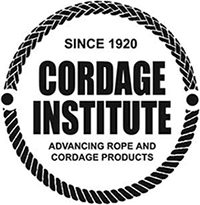Parachute cord was originally developed to act as suspension lines for parachutes used by airborne military units. It is a lightweight kernmantle style braided cord manufactured from nylon in accordance with military standard MIL-C-5040. Over time military personnel found this cord to be useful for many other tasks such as securing equipment, tag lines, general tying and even clothes lines.
Following WWII, parachute cord was found in many surplus outlets, resulting in growing demand for the product within civilian populations. Today it remains one of the most popular and versatile general purpose cords on the market. In additional to utilitarian functions, it is also widely used for decorative and braiding applications including bracelets, key chains, lanyards, and belts. As its use spread outside the military, it also started being referred to as 550 cord and Paracord. At the same time, lower spec, less expensive versions of this cord were developed and now permeate the market.
Despite the prevalence and popularity of the cord today, there remains confusion surrounding the difference between Military Grade Parachute Cord, and 550 Paracord. True Military Grade parachute cord is manufactured to the standard MIL-C-5040. There are varying types of cord that fall within that standard ranging in diameter, colour, spool length and core configuration. The Type III cord has a 3mm diameter with a 7 strand core, and is by far the most common variant of the MIL-C-5040 Standard.
Commercial or utility grade 550 paracord can look and feel identical to the MIL-C-5040 cord. However, there are some key differences:
- MIL-C-5040 requires that the cord be manufactured from nylon which has gone through a pre-treatment process prior to being manufactured into cord. The yarn used must be wet shrunk at specific temperatures, and for specific time frames which differ for the core and skin yarns. They must then go through a specific drying process prior to using. Commercial grade versions of this product would typically be manufactured from high tenacity nylon or polyester which is readily available to manufacturers at a fraction of the cost.
- MIL-C-5040 requires that a very fine yarn be plied up and wound onto each of the 32 braider carriers used to manufacture the product. Alternatively, when manufacturing commercial or utility grade 550 paracord, it would not be uncommon to use a larger feeder yarn on each of the 32 braider carriers.
- MIL-C-5040 mandates that the cord lose not more than 15% of its original breaking strength after exposure to light and heat, when tested in accordance with the standard.
- Cord manufactured to MIL-C-5040 must be manufactured from yarn produced within the previous two years.
- The yarn pre-manufacturing process combined with the other rigorous manufacturing requirements represents a significant input cost to producers, which in turn results
in the finished cord being much more expensive than the commercial and utility grade versions. For critical applications, this extra cost is well worth it. However, for decorative and other non-critical applications, a commercial grade Paracord is more than sufficient. As always, Cancord strives to have the ideal product available for every application. We always have both classes of cord available from stock.
This article was featured in Cancord Rope Talk Issue 1. Download the full newsletter here.





